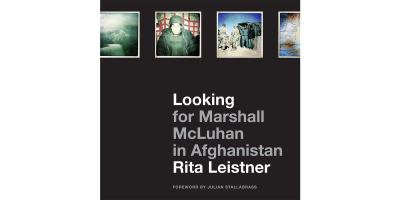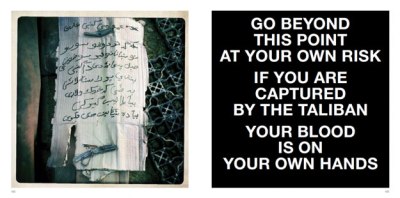Looking for Marshall McLuhan in Afghanistan

A 12-part LRC [Literary Review of Canada] series, featuring text and iPhone Hipstamatic photography by Rita Leistner . It covers territory originally explored by McLuhan in “War & Peace in the Global Village”(1968), using his ideas as the basis for a series of probes.
Editor’s note: this series ran from February 02 to March 13, 2012. It is best appreciated when followed from the first post. An archive of all the posts can be viewed here.
IPROBE 9_THE WRITTEN WORD – PROCEED AT YOUR OWN RISK

(photo: Rita Leistner/basetrack.org)
GO BEYOND THIS POINT AT YOUR OWN RISK
IF YOU ARE CAPTURED BY THE TALIBAN
YOUR BLOOD IS ON YOUR OWN HANDS
Writing is an extension of the hand and of the eye;
Writing is a visual artifact that stands in for man; The written word replaces the ear with the eye.
Photographs of signage explicitly show how written language is a visual artifact, a central theme of Marshall McLuhan’s The Gutenberg Galaxy. Grammar and style are kinds of behaviour that can reveal, through a close reading (exegesis), the sources of the texts.
McLuhan’s foundational concept is that language is a technology, and the written word (like unmanned Predator drones) is a way of conveying a message from a (safe) distance. He calls it “an eye for an ear,” (Understanding Media, p. 81) because writing comes from the oral and the acoustic (not the other way around). And while you can have a flourishing oral or “non-literate” culture with no written script, you can’t have the reverse.
McLuhan believed that in some ways this gives non-literate cultures an advantage over literate ones—their dependence on oral communication forces a closeness in the community, a kind of tribalism and unity, and simultaneously a resistance to written artifacts (language or propaganda) originating from outside the tribe. During the 2006 Hezbollah-Israel War, Predator drones dropped reams of leaflets warning the people of Lebanon against supporting Hezbollah leader Hassan Nasrallah. In Afghanistan, where the non-literacy rate is over 75 percent, and much higher in the remote areas most likely to support the Taliban, disseminating these kinds of flyers would be futile. The Taliban benefit enormously from non-literacy because it reduces the likelihood of individuals assimilating rogue information and separating from the tribal hive.
One day some Marines returned to the Shir Ghazay Patrol Base with a sign they’d found while on patrol. They’d gone out without an interpreter, so they carried it back to base to have it translated. It was handwritten in black marker on corrugated cardboard in a form of Arabic script, presumably Pashto (the dominant language of southern Afghanistan), and was fastened to a two-by-four with some nails and cut pieces of tire rubber. They said it was surrounded by three rocks that someone had painted red.
Interpreters are prime targets for the Taliban, who see them as enemy collaborators, and so for their own safety it’s not uncommon to go on routine patrols without them. Photojournalists protect the identities of interpreters for the same reason, blacking out their faces if they should appear in any photographs that might be published.
It’s hard to find enough Afghans with sufficient language skills willing to take the enormous risks of working for foreign militaries. Although most educated Afghans to some extent speak both official languages (Dari and Pashto), the vast majority of interpreters are from the north and Dari (also known as Afghan Persian) is their mother tongue. Dari and Pashto are both of Indo-European origin and both use a modified Arabic script for their writing, but the two languages are not mutually intelligible. The anthropologist Louis Dupree describes that “the difference between Dari and Pashto is analogous to the range of differences between English and German, or French and Spanish” (Afghanistan, p. 70).
One of the two interpreters on base struggled with the sign. “It’s very badly written,” he said. “I can’t fully make it out. But it is a warning of some kind from the Taliban.” The Marines mistook this to mean that the interpreter couldn’t read his own language, and they told him so. Another interpreter gave it a try and determined the sign had something to do with blocking the way—the three red painted rocks seemed to confirm that interpretation.
Even had the Marines wanted to return the sign so that others might heed its warning, it would have been too dangerous to go back.
I told this story to my friend François Lachance in Toronto, who wrote part of his PhD dissertation on McLuhan. The first thing he asked was: “Why didn’t the Marines just take a photograph of the sign”? It was as if they’d forgotten that writing is a visual artifact, and a camera is a photocopier.
Later, I showed my photograph of the sign to an Afghan scholar in Toronto—who is fluent in Pashto, Dari and Urdu—to see what she could make of it. I had already been told a few different things about the language of the sign, including that part of it was written in what looked like Urdu script, a language of Pakistan, from whence many Taliban hail. As it turns out, the sign is written in a kind of corrupted rural Pashto dialect by someone who had learned reading and writing outside the formal education system, probably at a madrasa (the village, or non-official, schools run by the mullahs, the religious preachers). Nor is the script an official Pashto, Dari or Urdu script, but some kind of variant created at the madrasas. Yet, however eccentric the writing may be, it is still a radical move from non-literacy. And as McLuhan repeats over and over again, the experience of phonetic literacy (like the Roman and Greek and Arabic alphabets) is a fundamental characteristic of those who possess literacy. So, however different we may be from whoever wrote that sign, the fact we share literacy at all is a more important commonality than that for which we might give credit.
The local nature of the writing on the sign meant that it would be nearly impossible for a native Dari speaker to accurately navigate. It would be something like a native English speaker with some formal education in French trying to decipher a French-based pidgin or creole like Haitian, or the language of the Labrador Inuit.
Here is a literal translation of the text:
Prohibited (prevent) for all,
If move from these holes (cavities or red points), her, him blood is at own hand (own neck). This prevention (blockade) point is going to the right side—then—if someone wanted to go, if arrested (captured) by Taliban, DO not have the rights to complain.
When you’ve heard enough foreign military yell in English in vain at locals, you get a pretty good idea of how little they appreciate language, let alone its correlative arts, translation and exegesis. Some of the Marines even thought the language of Afghanistan was Arabic (like in Iraq, where many of them had been previously deployed) so they couldn’t be expected to understand the differences between Dari and Pashto, or formal Pashto and a local dialect. They were able to identify the gist of the sign, and that was enough for them. But as a simple explication of the text shows, there was more to learn from the sign than meets the eye.
Works Cited
- Marshall McLuhan. The Gutenberg Galaxy: The Making of Typographic Man. Toronto: University of Toronto Press, 1962.
- Marshall McLuhan. Understanding Media: The Extensions of Man. Cambridge: The MIT Press, 1994.
- Louis Dupree. Afghanistan. Princeton: Princeton University Press, 1980.
Acknowledgment – The photographs in this series were produced as a part of the Basetrack Project. Basetrack is supported by a 2010 Newschallenge grant from the John S. and James L. Knight Foundation. http://appghanistan.reviewcanada.ca/

An ANA soldier attached to 1/8 searching for cell phone signal.
2011-01-29–Shir Ghazay Patrol Base, Landay Nawah County, Afghanistan. 1st Battalion 8th Marines Bravo Company 3rd Platoon.
Filed under: Articles, Blog Posts, Commentary, Ideas, Literature | Leave a Comment
Tags: articles, books, culture, global village, ideas


No Responses Yet to “Looking for Marshall McLuhan in Afghanistan”